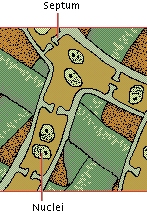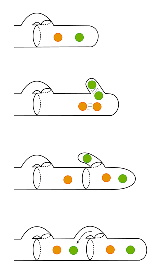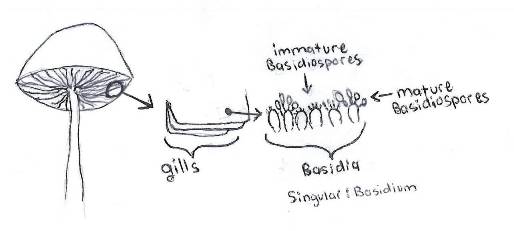Reproduction
The lifecycles of Fungi, specifically
Coprinopsis atramentaria, are unique
in that fact that they have a dikaryon stage included in their
alternation of generations. Other organisms that exhibit
an alternation of generations are the fungus
Aspergillus fumigatus
and the
Northern Maidenhair Fern. But to keep things
simple, lets start with the beginning of a single organism, then work our way to the
unique phenomena of "going inky."
the beginning of a single organism, then work our way to the
unique phenomena of "going inky."
Asexual reproduction: A haploid spore germinates and begins to grow hyphea which turn into a single primary mycelium. The mycelium would grow indefinitely and eventually produce spores through mitosis. Those spores would then create another individual mycelium, and the cycle continues.
Sexual reproduction: This is a
whole different ball-game. In order for sexual
reproduction to occur, two primary mycelia have to make physical
contact, in which case the cell walls of the two separate hyphae
fuse together (plasmogomy) to create a secondary mycelium.
This secondary mycelium now has two sets of distinct nuclei that
it has to accommodate for. Some fungi simply let the two
sets of nuclei replicate and move throughout the
 organism at free will. However Basidiomycetes are septated, meaning they
have partially separated cell-like regions that still have
continuous cytoplasmic flow (illustrated to the top right).
Connecting these "cells" are clamp connections that
distribute one of both sets of nuclei to each separate region
(illustrated to the left). In this Dikaryon
stage, the secondary mycelium continues to grow
indefinitely until an environmental factory, like
sunlight, or a change in oxygen concentration
triggers the growth of a fruiting body i.e. the
mushrooms we all know and love. Once this
mushroom gets closer to maturity it starts to line
its gills with basidia. One basidium houses
four basidiospores. Since these are sexual
spores, they come about from the nuclear fusion
(karyogomy) of the two distinct nuclei, then meiosis
followed by mitosis, giving us four haploid spores.
These spores are released at maturity and usually
dispersed by wind. However, Coprinopsis
atramentaria has evolved an extreme behavior that
assist in more affective spore dispersal.
organism at free will. However Basidiomycetes are septated, meaning they
have partially separated cell-like regions that still have
continuous cytoplasmic flow (illustrated to the top right).
Connecting these "cells" are clamp connections that
distribute one of both sets of nuclei to each separate region
(illustrated to the left). In this Dikaryon
stage, the secondary mycelium continues to grow
indefinitely until an environmental factory, like
sunlight, or a change in oxygen concentration
triggers the growth of a fruiting body i.e. the
mushrooms we all know and love. Once this
mushroom gets closer to maturity it starts to line
its gills with basidia. One basidium houses
four basidiospores. Since these are sexual
spores, they come about from the nuclear fusion
(karyogomy) of the two distinct nuclei, then meiosis
followed by mitosis, giving us four haploid spores.
These spores are released at maturity and usually
dispersed by wind. However, Coprinopsis
atramentaria has evolved an extreme behavior that
assist in more affective spore dispersal.

The picture to the right illustrates the basidia (singluar: basidium) that line the gills. They house the sexual spores that are made through karyogomy.
Now, it you're interested in its poisonous properties, when ingested with alcohol, click here.
